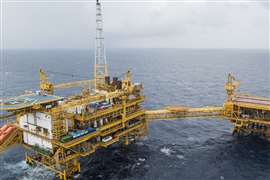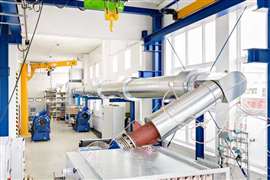Read this article in 中文 Français Deutsch Italiano Português Español
Natural gas pipelines offer power solutions
May 13, 2024
Growing demand for data centers spurs need for creative solutions for backup energy
By Steve Richards, Vice President of Engineering, Sapphire Technologies
Demand for data centers is booming, driven by investment in artificial intelligence applications. As demand for data centers increases, so too will the energy consumed by these server warehouses. According to McKinsey, data center energy consumption will increase from 17 gigawatts per year in 2022 to 35 gigawatts per year by 2030. For context, 35 gigawatts is roughly enough to power 30 million households! According to the International Energy Agency (IEA), emissions from data must be halved to achieve 2030 Net Zero goals. With demand for data centers skyrocketing, and existing grid issues already leading to financial and environmental losses for data center operators, these goals seem unrealistic unless we invest in reliable, clean energy solutions for data centers. In addition to the environmental benefits, addressing the challenge of reliable clean energy for data centers also has the potential to reduce the cost of data center outages for operators and their customers.
 Sapphire Technologies said its FreeSpin In-line turboexpander can recover energy wasted during pressure reduction processes and use it to generate zero emissions power. (Image: Sapphire Technologies)
Sapphire Technologies said its FreeSpin In-line turboexpander can recover energy wasted during pressure reduction processes and use it to generate zero emissions power. (Image: Sapphire Technologies)
Data center outages are already an expensive proposition. According to Uptime Institute, two-thirds of all outages cost more than $100,000 per outage. Uptime Institute suggests that several long-term trends are impacting the reliability of electricity grids which are the primary cause of data center outages. These trends include incorporation of intermittent renewable energy sources in the grid, aging infrastructure, more frequent weather-related disturbances, and geopolitical disruptions to traditional fossil fuel supplies. Because outages can cost thousands of dollars per minute, data center operators rely on backup energy sources to keep servers humming. Historically, these backup energy sources have largely included high-emissions diesel generators. According to one study conducted by engineering firm FEA based on data from the U.S. Energy Information Administration and EPA, a typical diesel generator emits more than double the CO2 as the US energy grid for every KWh of electricity generated. Thus, the environmental toll of data centers as their demand for energy increases and the reliability of the US electricity grid decreases, has the potential to increase exponentially if solutions to provide data centers with reliable, clean backup energy sources are not addressed.
Options available
The good news is several solutions already exist that can help data centers solve for both sustainability and energy reliability challenges. One such solution to backup energy for data centers are Lithium-ion batteries. These batteries can store energy generated from clean energy sources like renewables in a different location or at a different time for later use by data centers during power outages. While this technology is widely available, one challenge is cost. According to BloombergNEF, the levelized cost of electricity (LCOE) from Li-ion batteries as of 1H 2023 was $155/MWh. This compares unfavorably to traditional energy sources like natural gas ($92/MWh) as well as to renewable sources like solar ($76/MWh) and wind ($50/MWh).
Hydrogen fuel cells are another potential replacement backup energy source for data centers, as Microsoft is currently exploring. Hydrogen fuel cells offer zero-emission energy by producing electricity through a chemical reaction between hydrogen and oxygen. However, the economic viability of hydrogen is still very much in question and today hydrogen fuel cells would prove even more costly than Li-ion batteries according to most estimates.
Natural gas network
Another solution to providing data centers with reliable, cost-efficient, and clean backup energy involves a perhaps unlikely source – the natural gas distribution grid. However, this solution does not involve natural gas as an energy source in and of itself – but instead, harnesses waste energy created when pressure is reduced at various stages of the gas distribution network to create clean electricity. Sapphire Technologies’ FreeSpin® In-line Turboexpander can recover energy wasted during pressure reduction processes and use it to generate zero emissions power. Clean electricity produced from waste energy in pipelines can be consumed to power data centers. Since data centers offer a portable, modular load they are well-suited to co-location with pressure letdown stations, which are often found in remote locations. Sapphire Technologies has partnered with Tallgrass Energy and Evolve Energy to install 72 turboexpander generators across Tallgrass Energy’s 6,500-mile natural gas pipeline network in the US. The clean electricity generated will be consumed by Evolve Energy data centers. The data centers will be installed as close as possible to pressure letdown stations to minimize the need to run electric cables, further minimizing the infrastructure needed to utilize this clean energy source.
Sapphire Technologies’ FreeSpin In-line Turboexpander (FIT) extracts energy from the pressure reduction required at various stages of gas distribution. As natural gas is moved through pipelines, pressure energy is wasted at pressure letdown stations in the pipeline network. The FIT consists of an integrated high-speed turbine and a high-efficiency generator. It runs on magnetic bearings in a hermetically sealed lubrication-free unit. As pressurized gas flows through the FIT, it spins a radial turbine wheel and drives the permanent magnet generator with a variable speed drive. The drive can be programmed to specific power requirements, making it ideal for integration with devices like data centers. Furthermore, with an LCOE of $45/MWh, Sapphire’s FreeSpin In-line Turboexpander is a cost-efficient backup power source for data center operators compared to alternatives.
The FreeSpin In-line Turboexpander (FIT) can also be used to create clean electricity from waste energy upstream at natural gas wellheads. In addition to generating clean energy from waste energy in the natural gas supply chain, the FIT is “fuel-flexible.” The system is compatible with hydrogen, compressed air, and carbon dioxide applications.
As data centers continue to grapple with the challenge of reliable power consumption to support the growing demand from AI applications, creative solutions will be needed to balance energy reliability and affordability with emissions-reduction goals. While no solution is perfect, the ability to harness waste energy from traditional energy infrastructure is one interesting solution on the horizon.
MAGAZINE
NEWSLETTER

CONNECT WITH THE TEAM








